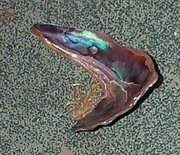Abalone is the Spanish name used in the United States for various species of shellfish (mollusks) from the Haliotidae family (genus Haliotis), with a richly coloured (on the inside--the outside is rough and mostly brown) shell yielding mother-of-pearl. This is also commonly called ear-shell, in Guernsey ormer (Fr. ormier, for oreille de mer), and paua in New Zealand. Abalone is also prevalent in Australian and South African coastal waters and is highly valued.
There is an extensive global black market in the collection and export of abalone meat. In New Zealand, where abalone is called paua in the Maori language, this can be a particularly awkward problem where the right to harvest paua can be granted legally under Maori customary rights. When such permits to harvest are abused, it is frequently difficult to police. The legal recreational daily limit is 10 paua per diver with a minimum shell length of 125mm. The limit is strictly enforced by roving Ministry of Fisheries officers with the backing of the Police force. Paua 'poaching' is a major industry in New Zealand with many thousands being taken illegally, often undersized. Convictions have resulted in siezure of diving gear, boats and motor vehicles as well as fines and in rare cases; imprisonment. The Ministry of Fisheries expects in the year 2004/05, nearly 1000 tons of paua will be poached, with 75% of that being undersized. [1] (http://http://www.fish.govt.nz/information/corp-docs/soi-04-08/pau2-industry-association.pdf) In regard to poaching, the Ministry is said to be "failing spectacularly".
The abalone shell is found especially at Santa Barbara and other places on the Californian coast from the south up to Fort Bragg and beyond, and when polished makes a beautiful ornament. The New Zealand paua are extremely popular as souvenirs with the striking blue, green and purple iridescence. The muscle tissue of the mollusc is often eaten, and the gonads of the abalone are delicacies in China and Japan.
There has been a trade in diving to catch abalones off parts of the USA coast from before 1939. In WWII many of these abalone divers were recruited into the USA armed forces and trained as frogmen.
Research
- Lin, A., and Meyers, M.A. 2005. Growth and structure in abalone shell, Materials Science and Engineering A 390(Jan. 15):27–41 (see abstract

